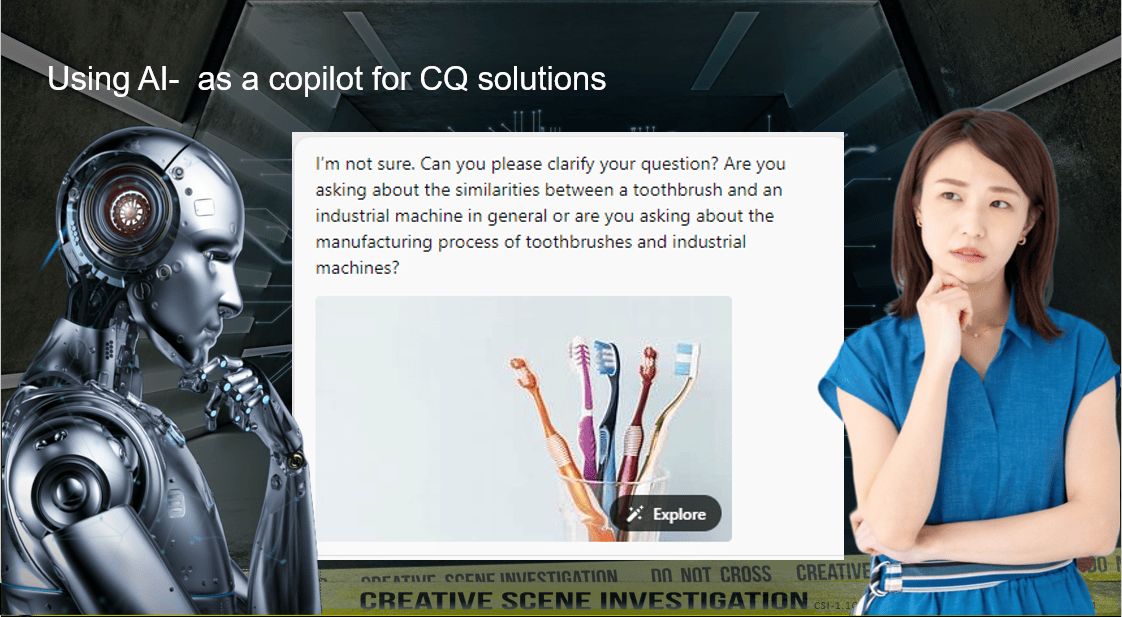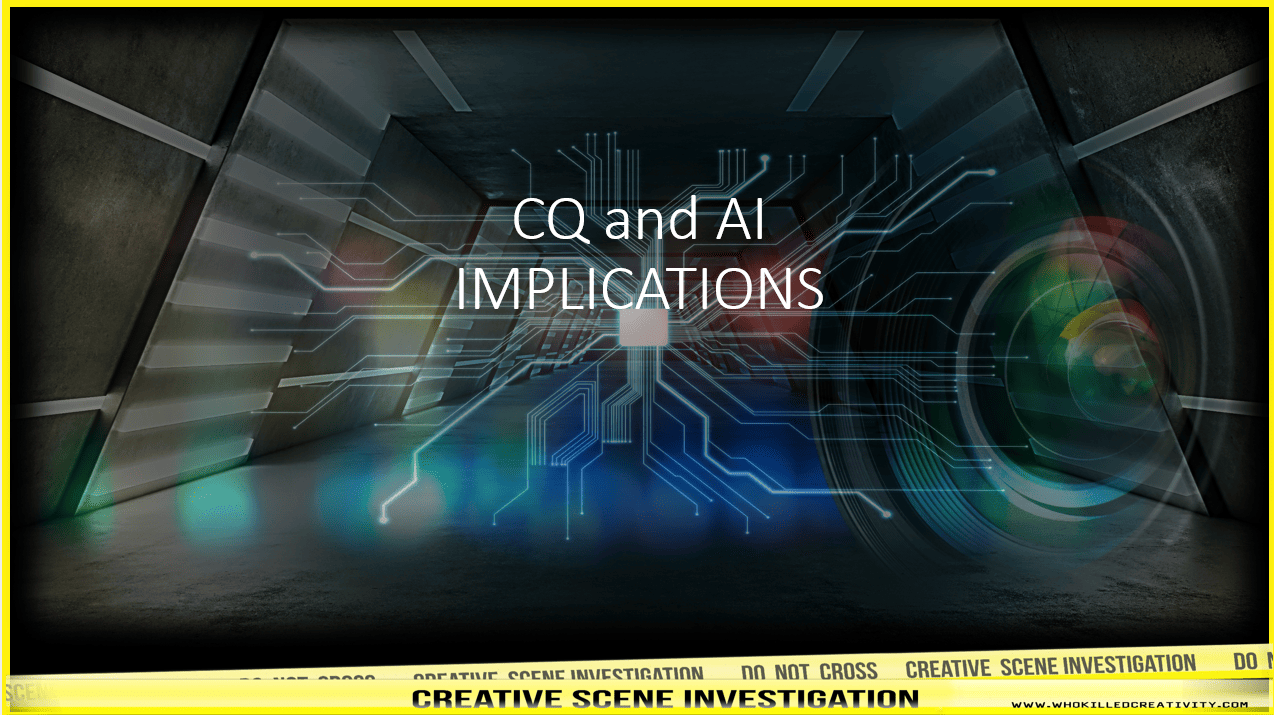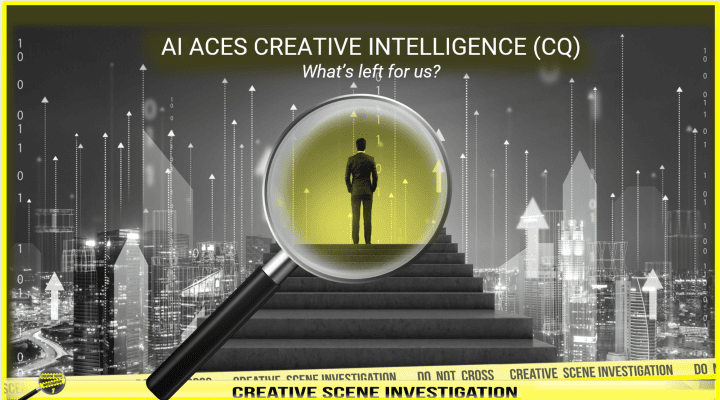AI ACES CREATIVE INTELLIGENCE (CQ) TESTS: What does this mean for us humans?
Artificial Intelligence (AI), or more specifically GPT-4, has been found to match the top 1% of thinkers on a standard creativity test. So if AI now aces creative intelligence tests, what value can we now add as humans?
When put through the Torrance Test of Creative Thinking, the long-established and widely recognised tool for assessing creative intelligence, the AI application ChatGPT-4 excelled in two key areas: originality and fluency (the ability to come up with a number of novel ideas fast). This breakthrough recent finding indicates that AI may be developing creative abilities on par with or even surpassing human capabilities.
Can you generate 800 ideas per hour?
In a challenge where ChatGPT-4 competed against 200 college students to devise a product for American college students under $50, it was not only able to generate a greater quantity of ideas but also did so more cost-effectively. The result was that ChatGPT-4 outperformed the majority of college students and ranked within the top 1% for originality, a significant milestone in the realm of AI creativity.
ChatGPT-4 exhibits an impressive idea generation rate of approximately 800 ideas per hour, translating to a remarkably low cost of about $0.63 per idea. This is in stark contrast to human-generated ideas, which cost approximately $25 each when working alone, and it makes a human using ChatGPT-4 nearly 40 times more productive.
Despite the impressive accomplishments of tools like ChatGPT-4, these findings also highlight the necessity for more advanced tools to distinguish between human and AI-generated ideas effectively.
This development holds tremendous potential for entrepreneurship and innovation, signalling a profound shift in the landscape. The key to harnessing maximum creativity will now lie in combining AI with human skills to yield innovative ideas that are not only groundbreaking but also practical and useful.
How to start leveraging generative AI for creativity
Similar to when ‘calculators’ were introduced as a significant evolution from pencil and paper calculations in maths, generative AI represents a profound shift. But rather than feeling threatened by it, we will need to adapt and harness it as a tool to enhance our creative potential.
The Torrence Test results over many years reveals that humans are readily influenced by social cues from their environment. When asked to create a picture from a random pointy doodle shape, for example, people often see the shape as a fin and turn the picture into a marine creature like a fish or a shark.
AI, on the other hand, lacks the ability to interpret social cues, making it appear to come up with more ‘original’ or less standardly expected ideas. So if you need to access a wider range of ideas faster without being restricted by the standard social filters, AI generated ideas can be a good option.
Be aware, though, that the flipside of this could be that AI might be considered less ‘insightful’. Additionally, it’s possible that the apparent uniqueness of the ideas AI generates could stems from exposure to a vast number of test results, leading to more different responses but still being limited within the range of responses already generated by humans.
When it comes to generating multiple ideas from a single drawing, which is the Torrence test for ‘fluency’, humans may find themselves at a disadvantage as they just can’t generate original interpretations as fast as AI. It’s therefore more helpful to view the opportunities of leveraging AI as a collaborative effort where humans can use AI to generate various options and add any of their own, can group and organize these options, and then can identify the most suitable solutions for the given context.

Co-piloting with AI in practice: an industrial case study
We once worked with a company that manufactured high-quality grease for industrial machines. The problem they faced was users neglecting recommended grease changes, leading to machine breakdowns and a tarnished reputation.
We ran a design thinking workshop to help management come up with potential recommendations on how to deal with this issue. During the workshop, we gave the participants an exercise to identify what the core reason behind the failures were, then to think of inventions from other industries that might give them inspiration for their challenge.
The team realised that the idea behind toothbrushes designed to indicate a significant amount of wear and tear through the bristles changing colour could be relevant for this context. Inspired by this idea, they decided they could infuse the grease with a chemical that would alter in smell when replacement was due, alerting users to the need for the oil to be changed.
When we recently asked Chat GPT to make a connection between another example that could provide inspiration for the grease company to see what it might come up with, the AI system couldn’t provide a clear answer. To us this emphasizes the importance of human creativity in drawing connections between diverse concepts.

Implications for creative practice
The World Economic Forum Future of Jobs Report for 2023 has identified that “as AI continues to advance and disrupt traditional job roles, it is becoming increasingly important for people to upskill by developing “inherently human” creative capabilities.”
Here are 5 recommendations for leveraging AI and building human CQ skills to ensure greater creative potential and a competitive business advantage:
- Combine the generative power of AI with human analytical and contextual skills to develop the most “novel ideas” that are also “useful”.
- Don’t just ask the AI to randomly generate ideas, identify relevant constraints and use them in the prompts to ensure ideas generated are targeted and relevant.
- As AI can be utilised as a skill leveller, helping to move low-performing workers to a much higher level of performance, encourage individuals who don’t feel they have creative potential to use generative AI to stimulate the creative process. The next step is to encourage them to challenge themselves to try generating ideas on their own after observing and learning from the AI generated solutions.
- Apply “lenses” to the problem by telling AI to think about radically different ideas that combine solutions from different spaces to enable more ‘outside the box’ outcomes.
- Make sure to dis-assemble familiar concepts and make completely new connections before launching into AI generated ideas. When we ask ourselves ‘what made that happen?’ We are learning to look for causes or underlying factors, or the building blocks behind every situation, not just the situation itself – and this helps to provide the nuances of the social context that brings in the human touch.
Don’t let AI kill your creativity.
Ask: what can you start doing differently to both leverage generative AI and utilise your unique human creative potential?
Learn more about how Tirian can address Creative Thinking Skills here with our CSI Creativity suite. ‘Harnessing CQ Skills For a Competitive Business Advantage.’
By Andrew Grant / Dr Gaia Grant (PhD)
https://tirian.com/create-innovate/future-proof-your-career-the-wef-future-of-jobs-report/
References:
Automating Creativity – by Ethan Mollick – One Useful Thing
AI Outperforms Humans in Creativity Test – Neuroscience New
[2303.12003] Artificial muses: Generative Artificial Intelligence Chatbots Have Risen to Human-Level Creativity (arxiv.org)
Generative AI can Ideate Harder. The world needs more breakthroughs —… | by Giannigiacomelli | Aug, 2023 | Medium


